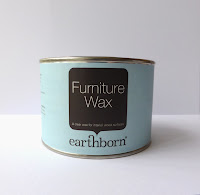I will be showing you how I get on soon here.
This is a blog to explore with you how to use and apply natural paint to make a fabulous toxin free environment. Also giving you guidance with various crafts to have your home look beautiful and unique.
Wednesday, 18 December 2013
A Great New Furniture Wax From Earthborn
Earthborn have just produced a great new furniture wax that goes perfectly with the new 750ml pots of Claypaint. You can now paint and finish a piece of furniture with these two products. It's not totally natural as it contains a little bit of isoparaffin which is derived from petrochemicals but doesn't smell toxic and I was fine when using it. I can tell immediately if people are going to have allergic reactions or respiratory problems with paints and finishes as I have an extreme reaction.
Friday, 6 December 2013
Allergies
Children breathing fumes from water-based paints have high risk of asthma, allergies, new study says
Children who sleep in bedrooms with fumes from water-based paints and solvents are two to four times more likely to suffer allergies or asthma, according to a new scientific study. Swedish and U.S. scientists measured the compounds – propylene glycol and glycol ethers – in the bedroom air of 400 toddlers and preschoolers, and discovered that the exposed children had substantially higher rates of asthma, stuffy noses and eczema. The irony is that these compounds are supposed to be healthier than the old, high-polluting, oil-based paints and solvents. See the complete article here www.environmentalhealthnews.org/ehs/news/glycol-ethers-and-allergies
What's in paint?
 |
| Pigment Mixed Into White Clay At IEKO |
Pigments. Safer alternatives to the toxic compounds and heavy metals used to color conventional paint include natural pigments derived from plants, insects, iron oxides and minerals. These are usually in powder form at artists’ supply stores.
Binders. Binders keep paint glued to a surface. The acrylic and vinyl binders in commercial paints are derived from the byproducts of refining crude oil. The binders in natural paints rely instead on materials such as starch (from flour), casein (the protein in milk) and linseed oil (from pressed flax seeds).
Fillers. Fillers create texture and add bulk to paint. Common fillers include whiting (powdered chalk), talcum, limestone, silica and marble. Clay is a popular filler to pair with flour, because it reinforces the binding ability of starch, and it’s abundant and potentially free if you have clay soil.
Solvents. Solvents, or thinners, help achieve a workable consistency. The solvents in commercial paints are usually made from organic materials, but they will evaporate or “outgas,” causing that new paint smell. The outgassing of these volatile organic compounds (VOCs) can cause headaches, nausea, dizziness, blurred vision and fatigue, especially in areas that are not well ventilated. The hazards are significantly worse for people who paint regularly. Natural solvents such as citrus thinners and natural turpentine are preferable, but they can still emit low levels of VOCs.
Subscribe to:
Posts (Atom)

